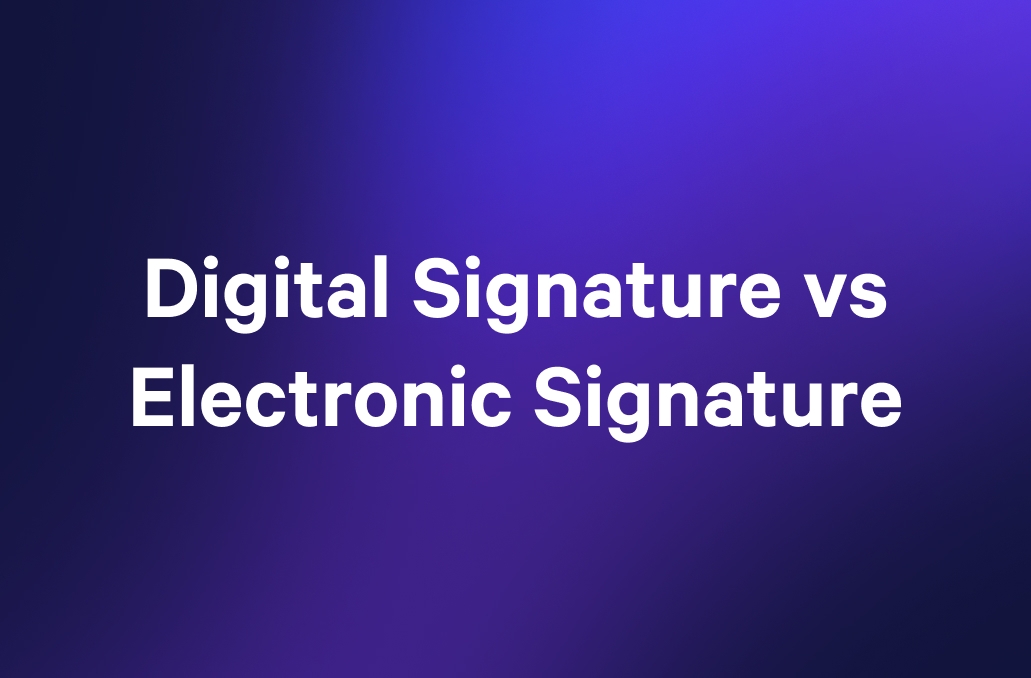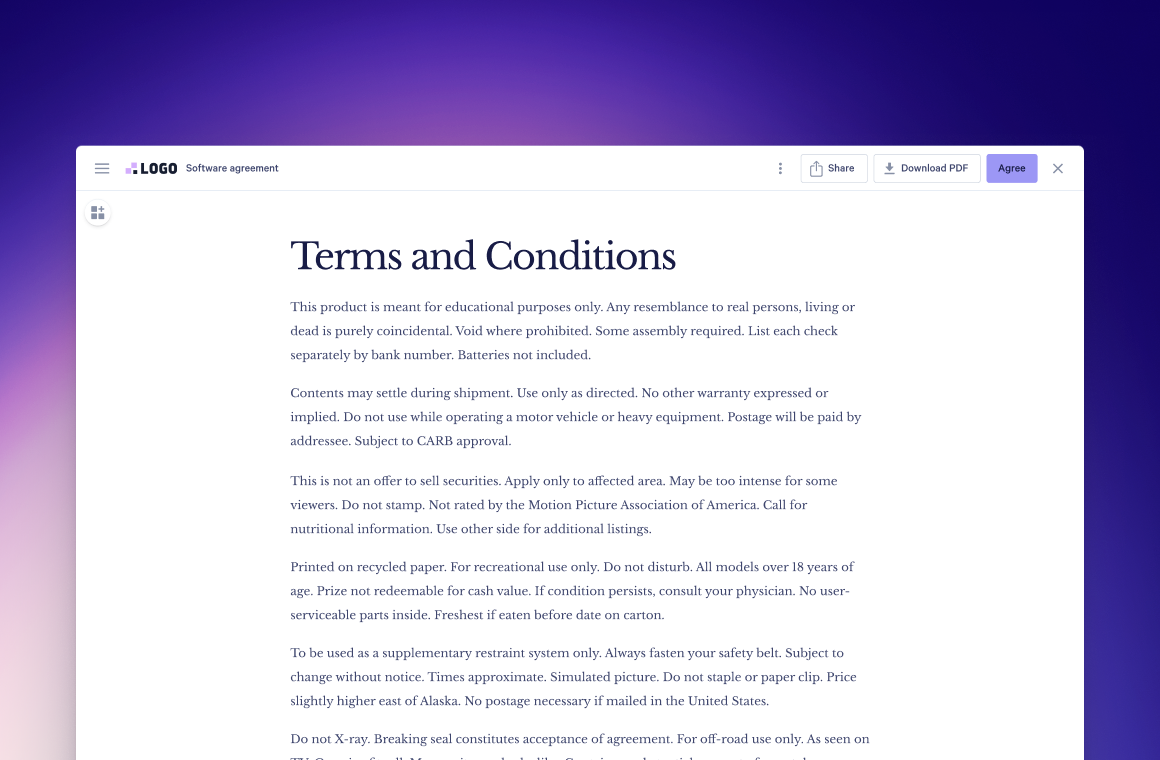A wet signature is an original handwritten mark made with ink on a physical document.
Picture the classic scene: blue or black ink flowing from a pen as someone signs their name on the dotted line. The term "wet" comes from the time needed for the ink to dry on the page.
Unlike electronic signatures, wet signatures require physical presence and leave a unique, permanent mark on paper. They've been the gold standard for centuries, carrying weight in legal proceedings because each signature is theoretically unique to the signer.
Key takeaways
- Wet signatures remain crucial for specific legal documents like notarized forms and international contracts, despite the growing acceptance of electronic alternatives in most business contexts.
- The ESIGN Act and UETA legislation give electronic signatures equal legal standing to wet signatures in most business transactions, making digital options viable for standard operations.
- Traditional ink signatures offer unique benefits including forensic verifiability, technology independence, and stronger psychological commitment through physical signing.
- Wet signatures present significant operational challenges including higher costs, logistical complexity, physical storage requirements, and lack of automated tracking capabilities.
- While tools like Qwilr primarily support electronic signatures, they can accommodate wet signature requirements through PDF export and scanning capabilities when necessary.
Do you still need a wet signature?
Most industries have moved away from requiring wet signatures, as electronic signatures are legally binding in many contexts. However, certain situations still call for traditional ink-on-paper signatures:
- Legal documents requiring notarization, such as deeds, affidavits, or sworn statements
- Government forms and visa applications that explicitly request original signatures
- Specific international business or sales contracts where local laws mandate physical signatures
- Medical directives or healthcare proxies in certain jurisdictions
- Some banking documents, particularly for high-value transactions
Beyond these exceptions, electronic signatures have become widely accepted across industries. The ESIGN Act of 2000 and the Uniform Electronic Transactions Act (UETA) give electronic signatures the same legal weight as wet signatures for most business transactions.
Pros of wet signatures compared to e-signatures
Physical signatures have lasted for centuries, even as digital options change how we do business. While creating electronic signatures has become more common, traditional wet signatures still have unique advantages.
- Familiarity and comfort for traditional clients. Many people, especially those less comfortable with technology, may find physical signatures more reassuring and trustworthy.
- Greater difficulty to forge due to unique physical characteristics. Handwriting experts can analyze pressure points, stroke patterns, and other distinctive features harder to replicate than digital credentials.
- No dependence on technology or internet connectivity. You can sign documents anywhere with just a pen, without worrying about system outages, password resets, or technical glitches.
- Creates a stronger psychological commitment through the physical act of signing. Research suggests that physically writing our signature activates neural networks associated with intention and commitment more strongly than clicking a button.
Cons of wet signatures compared to e-signatures
Traditional wet signatures have clear drawbacks, which is why many organizations are switching to digital alternatives. Besides the hassle of requiring a physical presence, they can slow down operations and add extra costs compared to e-signature benefits.
- Time-consuming and logistically complex for multi-party agreements. Documents must be physically transported between signers, often requiring coordination of schedules and shipping arrangements.
- Higher costs associated with paper, printing, and delivery methods. Beyond basic supplies, organizations must consider expenses for secure storage, courier services, and administrative time spent managing physical documents.
- Risk of physical damage or loss with no digital backup. Water damage, fire, or simple misplacement can permanently destroy important signed documents when there's no electronic copy.
- Manual tracking and reminder processes that drain resources. Teams must dedicate time to following up on unsigned documents and maintaining physical filing systems instead of using automated digital workflows.
- Lack of built-in authentication and verification features. Unlike e-signatures, wet signatures don't automatically create audit trails or timestamp records of who signed when.
How to create a wet signature with Qwilr
E-signature software like Qwilr is designed for electronic signatures, but you can still accommodate wet signatures. Here’s how.
First, as per electronic signature best practices, mark clear signature fields on the proposal document with labels indicating where wet signatures should be placed. Include date fields and any other required information.

Export your Qwilr document as a PDF using the export function in the top menu to create a printer-friendly version of your document.

Print the document for physical signing. Ensure all parties sign in the designated areas using blue or black ink for best visibility.
Scan the signed document and upload it to your preferred workspace for record-keeping. Store the physical copy in a secure location.
P.S. While Qwilr supports wet signatures through this process, consider using our native e-signature feature for faster, more secure, and environmentally friendly document signing.
Upgrade your signature workflow with Qwilr
Struggling with slow, outdated signing processes?
Knowing when to use wet vs. electronic signatures can save you time and keep you compliant. While ink signatures are still required in some legal contexts, digital solutions streamline most business needs.
Qwilr lets you send, track, and e-sign documents in one seamless platform—no attachments, no back-and-forth emails. Experience how our platform can transform your signing workflows and boost efficiency. Start your free 14-day trial today and simplify your signing process.
About the author

Kiran Shahid|Content Marketing Strategist
Kiran is a content marketing strategist with over nine years of experience creating research-driven content for B2B SaaS companies like HubSpot, Sprout Social, and Zapier. Her expertise in SEO, in-depth research, and data analysis allow her to create thought leadership for topics like AI, sales, productivity, content marketing, and ecommerce. When not writing, you can find her trying new foods and booking her next travel adventure."
FAQs regarding wet signatures
Professional alternatives include "physical signature," "handwritten signature," "original signature," or "ink signature." These terms convey the same meaning in a more formal context. Many legal and business documents use "manual signature" or "original handwritten signature" to specify when a wet signature is required rather than an electronic alternative.
While wet signatures can be photocopied, scanned, or digitally reproduced, these copies don't carry the same legal weight as the original ink signature in certain contexts. The original wet signature has unique physical characteristics, such as pressure points and ink distribution, that create a verifiable record. That's why some documents specifically require original wet signatures.
A wet signature itself must be physically written in ink, but it can be digitized after signing by scanning or photographing the document. This digital version is a copy of the original wet signature and can be useful for record-keeping or sharing. However, some legal situations may still require the original ink-signed document rather than the digitized version.


